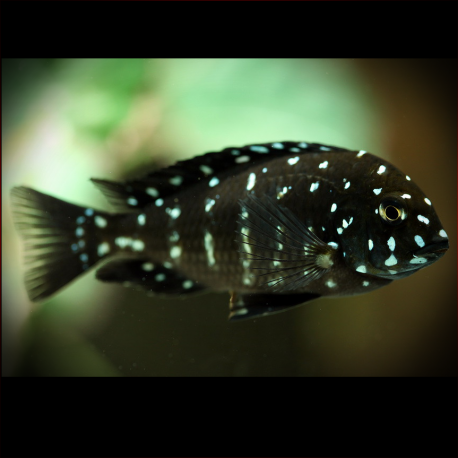More info
Datasheet
| Minimum Tank Size | 200 litres / 52.83 US gallons |
| Maximum Size | 12.7cm / 5.00inches |
| Temperament | Aggressive |
| Care Description | Moderate |
| Temperature | 22.2°C / 71.96°F - 27.8°C / 82.04°F |
| Carbonate Hardness | 10-20 |
| pH | 7.8-9.0 |
General Description
The Duboisi Cichlid, scientifically known as Tropheus duboisii, is a striking African cichlid originating from the rocky coastal waters of Northern Lake Tanganyika, Africa. As juveniles, they are entirely black with numerous white spots, which fade as they mature, displaying a blue coloration on their head. The adult Duboisi Cichlids develop a broad yellow band located just behind their pectoral fins, adding to their visually appealing appearance.
Aquarium Setup
To accommodate the Duboisi Cichlid, a minimum aquarium size of 200 litres is recommended (see table). It is advisable to keep them in large groups of at least six individuals, preferably in a species-specific tank setup. Incorporating plenty of rocks and African driftwood to create caves is essential for these aggressive fish. A sandy bottom of aragonite is ideal to maintain the high pH (7.8-9.0) and alkalinity (KH: 10-20).
Behaviour
Belonging to the Cichlidae family, Duboisi Cichlids are known for their aggressive temperament, particularly towards their own kind. They thrive in large groups and exhibit a social hierarchy within their group. Providing ample hiding spaces in the aquarium helps reduce aggression and provides a sense of security for each fish.
Feeding and Diet
Being herbivores, the diet of Duboisi Cichlids should be rich in vegetable matter. They can be fed dried seaweed or romaine lettuce daily, along with a quality vegetable-based flake or pellet food. Additionally, offering finely crushed flake food to fry in the initial months before transitioning to lettuce or seaweed enhances their nutritional intake.
Reproduction & Dimorphism
Reproduction for Duboisi Cichlids can be challenging, as they are mouthbrooders. It may take several years for these slow-growing fish to reach sexual maturity. Males typically exhibit a larger size and a more upturned nose than females. To increase the likelihood of successful spawning, it is advisable to keep a ratio of 5-6 females per male and provide multiple caves for the pair to select from.
Habitat and Distribution
The natural habitat of the Duboisi Cichlid is the rocky coastal waters of Northern Lake Tanganyika in Africa. In this environment, they are commonly found seeking refuge among rocks and crevices. The species is endemic to this region, showcasing their adaptability to the unique conditions of Tanganyikan waters.

